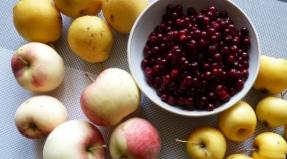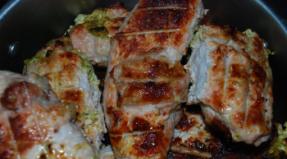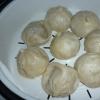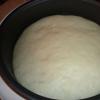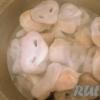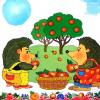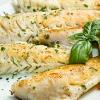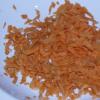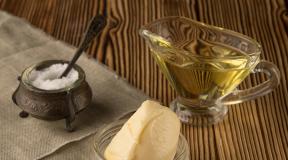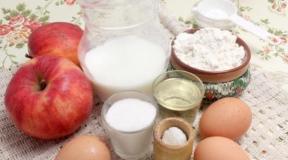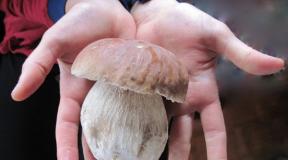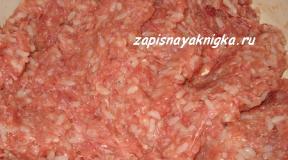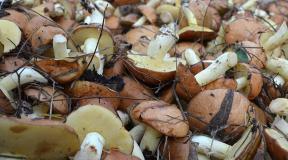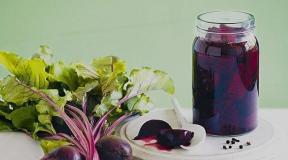What to do so that cut apples do not darken. Why do apples darken when cut? Apples are the best snack for those who are losing weight
Use lemon juice. Apples turn brown because the enzyme they contain reacts with the oxygen in the air. This process is called oxidation. Lemon juice can prevent oxidation because it contains citric acid, which is an effective antioxidant. You can use freshly squeezed or canned lemon juice. It is best to use this method only on sweet types of apples because the lemon juice will add astringency. You can use lemon juice to protect apples from oxidation in two ways:
Use salt. Salt is a natural preservative and can effectively protect apples from oxidation. Make a solution at the rate of 1/2 teaspoon of salt per liter of cold water. Place the chopped apples in the solution and let them soak for 3-5 minutes. Remove from water and rinse thoroughly with a colander or sieve. The pieces will not oxidize for a while.
- Don't worry about the fruit tasting salty, as long as you don't use too much salt, soak the apple for too long, and wash it thoroughly afterwards, the taste of the fruit won't change.
Use carbonated drinks. Carbonated drinks containing citric acid can also prevent apples from browning. Lemonades laced with lemon or lime, as well as ginger ale, are the most popular options for soaking apple slices.
Use a fruit freshener. This is a powdered mixture of citric and ascorbic acid that is specifically designed to prevent fruit from browning. The manufacturer claims that the product will protect fruits for up to 8 hours. You can find the powder in the canned food section of most grocery stores.
Blanch the apples. You can blanch apple slices to prevent browning. Blanching disables the enzymes in the apple and prevents it from reacting with the oxygen in the air. Simply place the apples in a pot of boiling water for about 5 minutes, then remove and rinse with cold water.
Wrap in plastic wrap. This is a very simple way to prevent apples from oxidizing; just wrap the cut piece in plastic wrap. This method helps, as the film protects the apple from air penetration, and therefore from oxidation. Try to wrap the apple as tightly as possible, without wrinkling the plastic wrap where it meets the slit in the fruit.
- This method is best used with half an apple rather than pieces, as it will be easier for you to wrap one piece with cling film.
- Remember, if air remains under the film, the apple will begin to oxidize. Since it is quite difficult to completely remove air from under the film, this method is not the most effective.
When we cut an apple or peel it, it darkens. This process is provoked by the presence in the fruit of an enzyme called polyphenol oxidase (ascorbic acid oxidase). This enzyme causes browning when oxygen interacts with the tannin substance found in apples.
Why does an apple darken on a cut: the answer to the question
When the fruit is cut, the cells that are directly on the cut immediately begin to interact with oxygen. Ascorbic acid oxidase causes the surface of an apple to change color when exposed to oxygen.
The fruit turns brown when exposed to air due to the oxidation process. The peel of an apple protects it from the oxidation process. But as soon as you make an incision on the fruit, its flesh immediately begins to oxidize and after a few minutes the apple darkens.
It is interesting to know that the temperature regime affects the rate of oxidation. For example, if you put a peeled apple in the refrigerator, it will darken only after a few hours or even a day. If you put the fruit in a hot oven, it will turn brown in a few minutes.
By the way, sour varieties darken faster than sweet ones. This is due to the fact that they have more of the enzyme oxidase. For example, the Granny Smith variety retains a light shade on the cut longer than other varieties.
So that apples do not darken when cut: life hack
If you need to prepare fruit slices, you are probably wondering how to prevent browning and make sure that the apple retains its beautiful color and juicy appearance.
Vitamin C will help you It is found in citrus juice. Just brush an apple slice with orange or lemon juice. Vitamin C prevents the tannin substance from reacting with oxygen, thus preventing browning. Keep in mind that when sprinkled with citrus juice, the apple will be sour.
 If you do not want the apples to be sour, sugar syrup will save them from browning. We prepare it according to the standard recipe,
then dip in syrup or brush it on the cut slice. This method not only protects against browning, but also gives the fruit a sweet taste.
If you do not want the apples to be sour, sugar syrup will save them from browning. We prepare it according to the standard recipe,
then dip in syrup or brush it on the cut slice. This method not only protects against browning, but also gives the fruit a sweet taste.
If there is no citrus juice or sugar syrup at hand, citric acid will come to the rescue. Add 1/4 tsp to cold water. citric acid, stir it until dissolved, then submerge the fruit for 10 minutes.
Sweet soda - it contains sugar and citric acid, they will prevent oxidation processes. Just drizzle a slice of fruit with sweet soda, you don't have to do anything else.
If you take an apple with you

This method is suitable for those cases when you need to take a whole cut apple on a trip, to work or school. . We cut it into two halves and take out the core, then put them together again and tighten with a rubber band. We pack in a package.
Now you know what causes the apple slice to darken. If you want to keep it fresh and beautiful, use our simple life hacks.
Why do apples darken when cut? As a rule, this question is answered as follows: due to the fact that atmospheric oxygen oxidizes the iron contained in apples. It is often added that if the apple does not darken after cutting or there is little “rust” on the cut, then the apple contains little iron. And that if you pour a slice of an apple with lemon juice, then the apple will not darken for a long time, because citric acid will bind iron ions.
Sounds convincing and believable. And yet, none of this is entirely true.
There is indeed iron in apples. One apple weighing 100 g contains about 1-2 milligrams of iron - a microscopic amount, completely insufficient to spoil the presentation of a whole fruit. Therefore, by the way, it makes no sense to treat iron deficiency in the body with the help of apples, especially when you consider that out of this meager amount, the body absorbs only 1-5%.
In fact, the mechanism for browning apples is completely different.
It is known that berries and fruits are rich in antioxidants, which largely determine their benefits for our health. Apples are rich in antioxidants called polyphenols. By structure, they are chains of molecules of various phenols, which look something like this:
Theaflavin-3-gallate is a plant-derived polyphenol
(it is known that phenol is the strongest poison, but phenol chains are substances with completely different properties, not toxic to humans at all).
In addition, apples contain polyphenol oxidase enzymes, whose task, as their name implies, is to oxidize polyphenols.
As a result of the oxidation of polyphenols, quinones are formed. By themselves, they are colorless, but unlike polyphenols, which by their nature prevent oxidation reactions, quinones, on the contrary, are the strongest oxidizing agents that, having formed on the surface of an apple cut, begin to interact with everything that gets in their way. As a result, substances are formed that give the apple a rusty color.
Why doesn't the flesh of a whole apple "rust"? The trick here is that oxygen is required for the interaction of polyphenol oxidase with polyphenols. When the integrity of the apple is damaged, oxygen gains access to the site of action and starts these processes.
If you treat an apple slice with citric acid, you can slow down its darkening. The secret lies in the fact that with an increase in acidity (chemists say: with a decrease in pH), the activity of polyphenol oxidases decreases.
What is all this for and what is the point?
The apple is thus protected from pests. The processes of oxidation of polyphenols, as you noticed, are launched only when the apple is damaged. In nature, this happens, for example, if a caterpillar gnawed a fruit. The first in the list of "defenders" of the apple are the quinones themselves, which, being strong oxidizing agents, are toxic to microorganisms and fungi. The brown "film" that forms on the damaged surface of the apple heals the damage and protects its flesh from penetration of the damage into the depths. And finally, the protective role is played by substances that are formed as a result of oxidation processes. Some of them can greatly spoil the caterpillar's digestion, others can make the fruit tasteless to her. Something similar happens when we eat sloes, bird cherry or unripe persimmons - their unpleasant astringent effect is due to the action of tannins tannins, which also belong to the class of polyphenols and coagulate proteins on the surface of the tongue and mucous membranes to form large "tasteless" molecules.
The rate of formation of a brown film and the intensity of its color are determined by the amount of polyphenols in a given variety of apples.
The same mechanism has darkening on the cut of bananas, peaches, unripe walnuts, potatoes, mushrooms.
The browning of the apple pulp on the cut gives it a not very appetizing look. Therefore, scientists have long wondered how this can be avoided. Varieties of apples have already been bred, in which the surface of the cut apple does not darken. This was achieved by blocking the genes responsible for the synthesis of polyphenol oxidases.

Apples of the "Arctic" variety, bred by Canadian specialists,
outwardly they are no different from ordinary apples, except that they do not darken on the cut
By the way...
Darkening under the action of polyphenol oxidase is not always an undesirable process. In some cases, they resort to it on purpose. For example, the fermentation of tea leaves, resulting in black tea, includes, among other things, the oxidation of catechins and other tannins by polyphenol oxidases. The quinones formed during these reactions, in turn, begin to act as strong oxidizers themselves and contribute to the formation of fragrant substances in tea.
In animals and humans, polyphenol oxidase (tyrosinase) oxidizes the amino acid tyrosine to form coloring pigments - melanins, which are responsible for the color of hair, iris, and skin.
The environment is amazing. And if children understand this easily, then with age they get used to many things and safely forget about it. As a result, the simplest questions of a baby can confuse an adult. For example: "Why does an apple darken when cut?" This process is very multifaceted, but not as simple as it seems at first glance. After all, different apples darken differently, and some do not darken at all.
Debunking the Myths
Most often, when asked about why an apple turns dark on the cut, they hear that this is due to the iron it contains. It is also known from the school chemistry course that iron has a valence (or oxidation state) of +2 and +3. So, in apples, it has the first. However, after cutting, it begins to actively come into contact with air, which contains oxygen. As a result, iron is oxidized to the +3 degree, thereby forming an oxide. It turns out that the apple just "rusts". And the color accepts the appropriate.
However, any chemist knows that this is not the case. One apple weighing about 150-160 grams contains only 3-4 mg of iron. Is this amount really enough to spoil the appearance of a whole fruit? Of course not. In fact, completely different substances are responsible for this. After all, this happens with pears and bananas. But they don't have that much iron.
True reasons
So, why does an apple darken on the cut if there is practically no iron in it? After damage to the fruit, a number of chemical reactions occur, due to which it loses its presentation. But if you follow the whole chain, you can still understand the true reason.

As you know, apples, like any other fruit, are rich in antioxidants. From the point of view of chemistry, they belong to the group of polyphenols. They have different names, but they have the same essence - this is a combination of different phenols (not to be confused with poison). Of course, by itself, this substance does not affect the color of the apple in any way, since it is simply colorless. But it still contains the enzyme polyphenol oxidase, which, after any damage, begins to actively interact with polyphenols. The main catalyst for the reaction is oxygen. And as a result, quinone is formed in large quantities in apples, and it is a strong oxidizing agent. This is the correct answer to the question of why the apple darkens on the cut.
How to fight?
Of course, this property of apples is not to the taste of many. Fruits quickly lose their attractive appearance, and even fresh cuts in just a couple of minutes begin to look not very attractive. Chefs have long come up with their own way of dealing with this shortcoming. To do this, it is enough to wipe the cut with a lemon peel or sprinkle with lemon juice. Another option is to dip the fruit in a solution of citric acid for 1-2 minutes. As a result, the apple does not darken on the cut.
For apple juice, another option has been invented. To do this, it is simply pasteurized for 20-30 minutes at 70-80 degrees. As a result, polyphenol oxidase is destroyed. This means that it is no longer possible to start the oxidation process in principle. For whole apples, this method, unfortunately, is not suitable.
Scientific approach
Obviously, by removing one of the three components of the reaction, it is possible to ensure that the apples do not darken. Unfortunately, it is impossible to get rid of polyphenols. In addition, they are believed to be beneficial to the body. And the first thing that was achieved was to exclude oxygen from the reaction. To do this, apples are coated with a special wax-like substance (according to the international standard, it is labeled E901-E913). True, it is advisable to wash off the coating before eating such fruits.

But science does not stand still. After all, it has long been known why the apple darkens on the cut. The presentation of a new genetically modified variety proved that by removing the oxidizing enzyme, one can simply get "eternal" apples. An excellent solution for supermarkets and restaurants. Moreover, for this it was only necessary to block some genes. It is believed that this technology is the most harmless.
Sliced apples are included in the recipes of many dishes - salads, pies, various desserts, etc. And in itself, apple slices decorate the table and attract the attention of guests.
But, unfortunately, apple slices quickly, in a matter of minutes, darken on the cut, losing their appetizing fresh look. However, it is easy to make sure that apples do not darken when cut: many different ways have been invented for this.
Why does a cut apple darken?
As you know, apple pulp contains a lot of iron. The most amazing thing is that this iron in apples is in a quickly digestible state, which is why red varieties of apples, the richest in this element, are recommended for people with anemia.
But it is iron that causes the darkening of apple slices: iron atoms react with oxygen in the air, forming iron oxide, which gives the pulp its characteristic brown color. So, to prevent browning, you need to prevent the contact of apple juice with air.
Method 1 - lemon juice
In order for the sliced apples not to darken as long as possible, they are sprinkled with lemon juice. For this, both freshly squeezed and canned juice is suitable. To evenly coat the slices with the juice, you can use a small spray bottle or pastry brush. This method is best suited for sweet varieties of apples, which, when combined with lemon juice, get a more refined taste.
If you have apples of sweet and sour varieties at your disposal, it is better to prepare a mixture of lemon juice and boiled water, taking no more than a tablespoon of juice for half a liter of water. Apple slices are dipped in acidified water, kept in it for about a minute and thrown into a colander.
An apple slice after such processing retains freshness for several hours. Instead of lemon, you can take lime, its juice has the same properties. If there is neither one nor the other, you can use a solution of citric acid by dissolving a teaspoon of the powder in a liter of water.
Method 2 - saline solution
Another available preservative is common table salt. A solution of a teaspoon of salt in a liter of water will also protect the apple slices from browning. You need to soak them in water with salt for several minutes, and then rinse well with clean water to wash off the salty taste. It is important here not to overexpose the apples in water so that the salt does not penetrate too deeply into the pulp.
Method 3 - carbonated lemonade
The composition of sweet carbonated drinks necessarily includes citric acid. If you soak apple slices in soda for 3-4 minutes, they will remain fresh and attractive for several hours.

You can rinse the apples after processing, or you can leave a light layer of carbonated drink on them, which will add additional flavor and aroma to the slices.
Method 4 - sliced fruit freshener
Some supermarkets sell a special powder to combat the browning of fruits on cuts. It consists of a mixture of ascorbic and citric acid, and it can be prepared independently. Buy glucose tablets with ascorbic acid at the pharmacy, grind into powder and mix with citric acid. Sprinkle a small amount of the mixture over the slices and mix well so that the powder is evenly distributed.
Method 5 - blanching
In order to stop the oxidative process, apples can be blanched, i.e. drop into boiling water for a few minutes. For soft apples, one or two minutes in boiling water is enough, you can hold it a little longer. True, this method is not suitable for apple slices, which are supposed to be served, as the apples will become too soft and change the taste a little.
But if the slices will go into the filling of the pie or will be used as a component of the salad, blanching will be the best option. After pulling the apples out of the water, they need to be thrown into a colander and doused with a cold stream, and then let the water drain.
Method 6 - cling film
If you cut off half of a large apple and want to save the other half for later, wrap it as tightly as possible in cling film to block air access, and put it in the refrigerator. If everything is done correctly, the apple slice will remain fresh for a day.

Instead of cling film, you can use a plastic bag with a zip. Putting half an apple in it, you should carefully squeeze out the air from there and fasten the bag.
Method 7 - rubber band
This method is suitable for those who take a chopped apple with them to study or to the office. The washed apple must be cut into slices, removing the core, and then fold these slices to make a whole apple again.
Now you need to carefully pull the slices with an elastic band so that they do not crumble, and lower them into the bag. After removing the cutters, the slices will be fresh, white and juicy, as if they had just been cut off.
The environment is amazing. And if children understand this easily, then with age they get used to many things and safely forget about it. As a result, the simplest questions of a baby can confuse an adult. For example: "Why does an apple darken when cut?" This process is very multifaceted, but not as simple as it seems at first glance. After all, different apples darken differently, and some do not darken at all.
Debunking the Myths
Most often, when asked about why an apple turns dark on the cut, they hear that this is due to the iron it contains. It is also known from the school chemistry course that iron has a valence (or oxidation state) of +2 and +3. So, in apples, it has the first. However, after cutting, it begins to actively come into contact with air, which contains oxygen. As a result, iron is oxidized to the +3 degree, thereby forming an oxide. It turns out that the apple just "rusts". And the color accepts the appropriate.
However, any chemist knows that this is not the case. One apple weighing about 150-160 grams contains only 3-4 mg of iron. Is this amount really enough to spoil the appearance of a whole fruit? Of course not. In fact, completely different substances are responsible for this. After all, this happens with pears and bananas. But they don't have that much iron.
True reasons
So, why does an apple darken on the cut if there is practically no iron in it? After damage to the fruit, a number of chemical reactions occur, due to which it loses its presentation. But if you follow the whole chain, you can still understand the true reason.

As you know, apples, like any other fruit, are rich in antioxidants. From the point of view of chemistry, they belong to the group of polyphenols. They have different names, but they have the same essence - this is a combination of different phenols (not to be confused with poison). Of course, by itself, this substance does not affect the color of the apple in any way, since it is simply colorless. But it still contains the enzyme polyphenol oxidase, which, after any damage, begins to actively interact with polyphenols. The main catalyst for the reaction is oxygen. And as a result, quinone is formed in large quantities in apples, and it is a strong oxidizing agent. This is the correct answer to the question of why the apple darkens on the cut.
How to fight?
Of course, this property of apples is not to the taste of many. Fruits quickly lose their attractive appearance, and even fresh cuts in just a couple of minutes begin to look not very attractive. Chefs have long come up with their own way of dealing with this shortcoming. To do this, it is enough to wipe the cut with a lemon peel or sprinkle with lemon juice. Another option is to dip the fruit in a solution of citric acid for 1-2 minutes. As a result, the apple does not darken on the cut.
For apple juice, another option has been invented. To do this, it is simply pasteurized for 20-30 minutes at 70-80 degrees. As a result, polyphenol oxidase is destroyed. This means that it is no longer possible to start the oxidation process in principle. For whole apples, this method, unfortunately, is not suitable.
Scientific approach
Obviously, by removing one of the three components of the reaction, it is possible to ensure that the apples do not darken. Unfortunately, it is impossible to get rid of polyphenols. In addition, they are believed to be beneficial to the body. And the first thing that was achieved was to exclude oxygen from the reaction. To do this, apples are coated with a special wax-like substance (according to the international standard, it is labeled E901-E913). True, it is advisable to wash off the coating before eating such fruits.

But science does not stand still. After all, it has long been known why the apple darkens on the cut. The presentation of a new genetically modified variety proved that by removing the oxidizing enzyme, one can simply get "eternal" apples. An excellent solution for supermarkets and restaurants. Moreover, for this it was only necessary to block some genes. It is believed that this technology is the most harmless.
